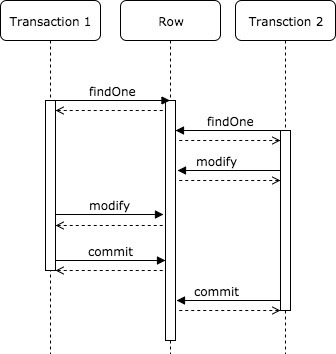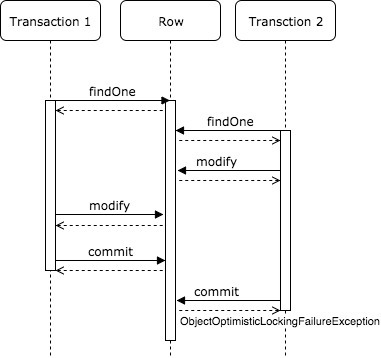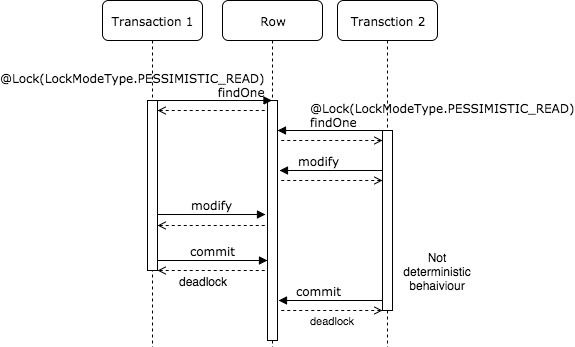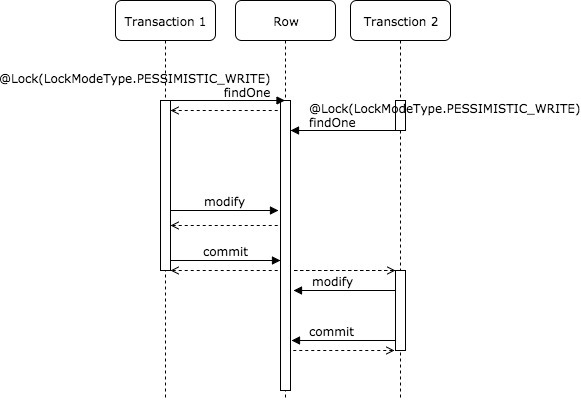Database locking
In this article, you will find information on:
- Optimistic read,
- Pessimistic read,
- Pessimistic write.
I will cover the topic in context of:
- Hibernate with Spring,
- PostgreSQL database (but it works in the same way on MySQL),
- Isolation level - read committed,
Example of the working Java/SQL code you can find here.
Why do you need to lock a resource in a database?
Let’s say that you have two transactions that are overlapping:
- Transaction 1 reads row,
- Transaction 2 reads row,
- Both transactions are modifying one column in the row,
- Transaction 1 commits the changes
- Transaction 2 commits the changes and overwrites the changes from transaction 1.

It can happen in many scenarios. The very common problem are two HTTP requests or queue consumptions coming one after another.
How to add locking
To add locking to your JpaRepository, you need to annotate the interface method with @Lock annotation. Here is an example of PESSIMISTIC_WRITE:
@Repository
public interface EntityRepository extends JpaRepository<Entity, Long> {
@Lock(LockModeType.PESSIMISTIC_WRITE)
Optional<Entity> findById(Long id);
}
If you annotate the method with body it will not work:
@Repository
public interface EntityRepository extends JpaRepository<Entity, Long> {
@Lock(LockModeType.PESSIMISTIC_WRITE) // IT WILL NOT WORK
default Card findOneAndLock(String id) {
return findOne(id);
}
}
Of course, you can create a native query with syntax SELECT ... FROM TABLE FOR UPDATE.
Locking types
None
LockModeType.NONE is a default behavior of JPA. It means there is no locking. Hibernate queries looks like this:
select entity_.created as created2_2_ from entity entity_ where entity_.id=?
update entity_without_version set created=?, description=? where id=?
Optimistic locking
To use optimistic locking (LockModeType.OPTIMISTIC, synonym LockModeType.READ):
- Annotate the method with @Lock(LockModeType.PESSIMISTIC_WRITE)
- Add @Version field in your entity. Supported types:
- int,
- Integer,
- short,
- Short,
- long,
- Long,
- java.sql.Timestamp
If there is a different version of the @Version field in the database, ObjectOptimisticLockingFailureException is thrown.

Hibernate queries looks like this:
select entitywith0_.id ... from entity entity0_ where entity0_.id=?
update entity set created=?, description=?, version=? where id=? and version=?
The good source of information about optimistic lock is here.
OPTIMISTIC_FORCE_INCREMENT
OPTIMISTIC_FORCE_INCREMENT – it obtains an optimistic lock the same as OPTIMISTIC and additionally increments the version attribute value.
Pessimistic read
To use pessimistic read (LockModeType.PESSIMISTIC_READ):
- Annotate the method with @Lock(LockModeType.PESSIMISTIC_READ).
It means that other transactions may concurrently read the entity, but cannot concurrently update it (if both use select for share).
Hibernate queries looks like this:
Hibernate: select entity0_.id as id1_2_0_, entity0_.created as created2_2_0_,
entity0_.description as descript3_2_0_
from entity entity0_ where entity0_.id=? for share
There is a deadlock if two transactions use PESSIMISTIC_READ and try to modify the row. Random transaction interrupted with this exception (no matter which one started first). You can still read data using a classical repository (without any locking strategy).

Personally, I find the pessimistic read to be the least useful locking type.
Pessimistic write
To use pessimistic write (LockModeType.PESSIMISTIC_WRITE):
- Annotate the method with @Lock(LockModeType.PESSIMISTIC_WRITE).
Other transactions cannot concurrently read or write the entity (if both use select for update).
You can still read data using a classical repository (without any locking strategy).
Hibernate queries looks like that:
select entity0_.id as id1_2_0_, entity0_.created as created2_2_0_,
entity0_.description as descript3_2_0_ from entity entity0_ where entity0_.id=? for update

Locking MIX
You can mix PESSIMISTIC_WRITE + OPTIMISTIC. Add version field and use PESSIMISTIC_WRITE
Alternative solutions
You may lock resources in many ways, for example:
- in Redis (for example using Redisson)
- files.
Summary
Locking resources is not a trivial task. Database locking is easy to implement and can be applied in many enterprise applications.
| Lock type | |
|---|---|
| optimistic locking | you can read, but the exception is thrown during write if version field doesn’t match. |
| pessimistic read | you can read entity, but you cannot write |
| Pessimistic write | you lock entity for reading |
| mix | you cannot read and write if version field doesn’t match. |